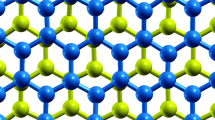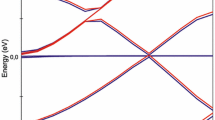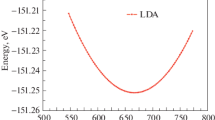Abstract
Based on first-principles calculations using density functional theory, this paper systematically studies the effects of uniaxial tension-compression deformation on the stability and electrical and thermal properties of monolayer graphene and AA stacked bilayer graphene. The study shows that the original symmetry of graphene is broken by the tensile and compression deformations, catalyzing the interlayer coupling of bilayer graphene. Its electronic energy band, phonon dispersion, and other physical properties have changed. The transition from metalloid to semiconductor has completed since the deformation weakens the stability of the graphene system to varying degrees and opens the band gap of monolayer graphene. The band gap becomes larger with the increase of tensile and compressive deformation, in which way it can be adjusted. Influenced by the tiny tensile deformation, metalloid properties are exhibited by a small band gap of intrinsic AA-stacked bilayer graphene, and then the band gap becomes larger as the deformation increases. A band gap appears in the system phonon dispersion curves when the compression deformation increases to −15%. The phonon mode softens and shows virtual frequency. The value of virtual frequency increases with the increase of compression deformation. At the very moment, the vibration mode is discontinuous, and the system is unstable.











Similar content being viewed by others
Data availability
Data sharing is not applicable to this article as no datasets were generated or analyzed during the current study.
Code availability
Code availability is not applicable to this article as no codes were used during the current study.
References
Novoselov KS, Geim AK, Morozov SV, Jiang D, Zhang Y, Dubonos SV, Grigorieva IV, Firsov AA (2004) Electric field effect in atomically thin carbon films. Science 306(5696):666–669
Zheng XH, Wang XL, Huang LF, Hao H, Lan J, Zeng Z (2012) Stabilizing the ground state in zigzag-edged graphene nanoribbons by dihydrogenation. Phys Rev B Condens Matter 86(8):3305–3307
Zhang Z, Peng J, Hua Z (2001) Low-temperature resistance of individual single-walled carbon nanotubes: a theoretical estimation. Appl Phys Lett 79(21):3515–3517
Mccann E, Koshino M (2013) The electronic properties of bilayer graphene. Rep Prog Phys 76(5):056503
Miller JR, Outlaw RA, Holloway RC (2010) Graphene double-layer capacitor with ac line-filtering performance. Science 329(5999):1637–1639
Xie Y, Zhang WT, Cao S, Zhou AN, Zhang JM (2019) First-principles study of transition metal monatomic chains intercalated AA-stacked bilayer graphene nanoribbons. Physica E Low Dim Syst Nanostruct 106:114–120
Novoselov KS, Geim AK, Morozov SV, Jiang D, Katsnelson MI, Grigorieva IV, Dubonos SV, Firsov AA (2005) Two-dimensional gas of massless Dirac fermions in graphene. Nature 438:197–200
Abergel DSL, Fal'Ko VI (2007) Optical and magneto-optical far-infrared properties of bilayer graphene. Phys Rev B Condens Matter 75(15):1418–1428
Martins TB, Miwa RH, da Silva Antônio JR, Fazzio A (2007) Electronic and transport properties of boron-doped graphene nanoribbons. Phys Rev Lett 98(19):304–308
Liu Z, Suenaga K, Harris PJF, Iijima S (2009) Open and closed edges of graphene layers. Phys Rev Lett 102(1):015501. https://doi.org/10.1103/PhysRevLett.102.015501
Li G, Luican A, Santos JMBLD, Neto AHC, Andrei EY (2009) Observation of Van Hove singularities in twisted graphene layers. Nat Phys 6(2):109–113
Lee JK, Lee SC, Ahn JP, Kim SC, Wilson JIB, John P (2008) The growth of AA graphite on (111) diamond. J Chem Phys 129(23):749
Roy HV, Kallinger C, Sattler K (1998) Study of single and multiple foldings of graphitic sheets. Surf Sci 407(1–3):1–6
Fang-Ping O, Li-Jian C, Jin X, Hua Z (2011) Electronic properties of bilayer zigzag graphene nanoribbons: first principles study. Chin Phys Lett 28(4):47304–47304
Denis, P., Iribarne, F. (2016) The effect of the dopant nature on the reactivity, interlayer bonding and electronic properties of dual doped bilayer graphene. Physical Chem ChemPhysics Cambridge R Soc Chem
Denis PA, Huelmo CP (2015) Structural characterization and chemical reactivity of dual doped graphene. Carbon 87:106–115
Denis PA, Iribarne F (2016) Dual doped monolayer and bilayer graphene: the case of 4p and 2p elements. Chem Phys Lett 658:152–157
Denis PA (2017) Band gap opening in bilayer graphene by the simultaneous adsorption of electron donating and electron acceptor molecules. Comp Theor Chem 1120:96–101
Zhang X, Xu W, Dai J, Liu Y (2017) Role of embedded 3d transition metal atoms on the electronic and magnetic properties of defective bilayer graphene. Carbon 118:376–383
Zhang X, Zhao X, Liu Y (2017) Ab initio study of structural, electronic and magnetic properties of transition metal atoms intercalated AA-stacked bilayer graphene. J Physical Chem C:acs.Jpcc.6b07488
Tang Y, Liu Z, Chen W, Shen Z, Wang X, Dai X (2016) The adsorption behaviours of Pt adatom on pristine and defective bilayer graphene. Mol Phys:1–9
Liao JH, Zhao YJ, Tang JJ, Yang XB, Xu H (2016) High-coverage stable structures of 3d transition metal intercalated bilayer graphene. Phys Chem Chem Phys 18(21):14244–14251
Ohta T (2006) Controlling the electronic structure of bilayer graphene 313(5789):951–954
Li Z, Qian H, Wu J, Gu BL, Duan W (2008) Role of symmetry in the transport properties of graphene nanoribbons under bias. Phys Rev Lett 100(20):206802
Son YW, Cohen ML, Louie SG (2007) Erratum: energy gaps in graphene nanoribbons [Phys. Rev. Lett. 97, 216803 (2006)]. Phys Rev Lett 98(8):89901
Zhuhua Z, Wanlin, Guo (2009) Electronic properties of zigzag graphene nanoribbons on Si(001). Appl Phys Lett 95(2):23107–23107
Cao Y, Fatemi V, Fang S, Watanabe K, Taniguchi T, Kaxiras E, Jarillo-Herrero P (2018) Unconventional superconductivity in magic-angle graphene superlattices. Natur 556
Liu J, Wang Z, Ling D, Wei D, Chen YF (2021) Synchronous growth of 30°-twisted bilayer graphene domains with millimeter scale. 2D Mater
Kubakaddi SS (2020) Large power dissipation of hot Dirac fermions in twisted bilayer graphene. J Phys Condens Matter 33(11):115704
Lee CC, Hsu CE, Hsueh HC (2021) Partitioning interatomic force constants for first-principles phonon calculations: applications to NaCl,PbTiO$_3$, monolayer CrI$_3$, and twisted bilayer graphene. J Phys Condens Matter 33 (5)
Yang X, Zhang B (2020) Twisted bilayer graphene/ h -BN under impact of a nano-projectile. Appl Surf Sci 8:538
Choi Y, Kim H, Peng Y, Thomson A, Nadj-Perge S (2021) Correlation-driven topological phases in magic-angle twisted bilayer graphene. Nature 589:536–541
Fischer A, Klebl L, Honerkamp C, Kennes DM (2021) Spin-fluctuation-induced pairing in twisted bilayer graphene
Da Liao Y, Xu XY, Meng ZY, Kang J (2020) Correlated insulating phases in the twisted bilayer graphene
Wen L, Li Z, He Y (2021) Optical conductivity of twisted bilayer graphene near the magic angleProject supported by the National Natural Science Foundation of China (Grant Nos. 11874271 and 11874272). Chin Physics B 30(1):017303
Laref A, Alsagri M, Alay-E-Abbas SM, Laref S, Wu X (2020) Electronic structure and optical characteristics of AA stacked bilayer graphene: a first principles calculations. Optik - International Journal for Light and Electron Optics 206:163755
Xie Y, Cao S, Wu X, Yu BY, Zhang JM (2020) Density functional theory study of hydrogen sulfide adsorption onto transition metal-doped bilayer graphene using external electric fields. Physica E Low-dim Syst Nanostruct 124:114252
Ge Y, Fisher TS (2020) Photoconductivity calculations of bilayer graphene from first principles and deformation-potential approach
Li S, Zhao JM, Li LL, Dong W (2020) Sodium adsorption and intercalation in bilayer graphene doped with B, N, Si and P: a first-principles study. J Electron Mater 49:6336–6347 1–12
Zamri FA, Abu Bakar MH (2020) First-principle calculations of the effects of intrinsic defects in bilayer graphene as a positive electrode material for aluminum-ion batteries. Mater Today Communications 25:101641. https://doi.org/10.1016/j.mtcomm.2020.101641
Kim KS, Zhao Y, Jang H, Lee SY, Kim JM, Ahn JH, Kim P, Choi JY, Hong BBH (2009) Large-scale pattern growth of graphene films for stretchable transparent electrodes. Nature 457(7230):706–710
Nguyen CV, Hieu NV, Nhan LC, Phuc HV, Iiyasov VV, Hieu NN (2017) First-principles study of electronic properties of AB-stacked bilayer armchair graphene nanoribbons under out-plane strain. Indian J Physics 92(4):447–452
Tang B, Luo Q, Zhang Q, Wu ZH, Ran ZL (2014) First principles study on the structure and electronic properties of P doped graphene. J Synthetic Crystals 43(5):1269–1273
Perdew JP, Burke K, Ernzerhof M (1996) Generalized gradient approximation made simple. Phys Rev Lett 77(18):3865–3868. https://doi.org/10.1103/PhysRevLett.77.3865
Carlsson JM, Scheffler M (2006) Structural, electronic, and chemical properties of nanoporous carbon. Phys Rev Lett 96(4):046806
Paulla KK, Farajian AA (2013) Stacking stability, emergence of magnetization and electromechanical nanosensing in bilayer graphene nanoribbons. J Phys Condens Matter 25(11):115303
Avouris P, Chen Z, Perebeinos V (2007) Carbon-based electronics. Nat Nanotechnol 2(10):605
JianPing S, YingMeng M, XiangChun C (2013) Density functional theory studies of O2 and CO adsorption on the graphene doped with Pd. Acta Phys Sin 63(3):36301–036301
Zhong Y, Zhong D, Xi-Zheng K, Zhen C (2016) Optical and electronic properties of N/B doped graphene. Acta Phys Sin 65(24):248103. https://doi.org/10.7498/aps.65.248103
Varykhalov A, Sanchez-Barriga J, Shikin AM, Biswas C, Vescovo E, Rybkin A, Marchenko D, Rader O (2008) Electronic and magnetic properties of quasifreestanding graphene on Ni. Phys Rev Lett 101(15):157601
Bao C, Yao W, Wang E, Chen C, Avila J, Asensio MC, Zhou S (2017) Stacking-dependent electronic structure of trilayer graphene resolved by nanospot angle-resolved photoemission spectroscopy. Nano Lett 17(3):1564–1568
Zhang Y, Tang TT, Girit C, Hao Z, Martin MC, Zettl A, Crommie MF, Shen YR, Wang F (2009) Direct observation of a widely tunable bandgap in bilayer graphene. Nature 459(7248):820–823
Wu YA, Kirkland AI, Schäffel F, Porfyrakis K, Warner JH (2011) Utilizing boron nitride sheets as thin supports for high resolution imaging of nanocrystals. Nanotechnology 22(19):195603
Kumar D, Verma V, Bhatti HS, Dharamvir K (2013) Phonon dispersions in graphene sheet and single-walled carbon nanotubes. Pramana 81(6):1021–1035
Ge XJ, Yao KL, Lue JT (2016) Comparative study of phonon spectrum and thermal expansion of graphene, silicene, germanene and blue phosphorene. Phys Rev B Condens Matter 2115(1):030386
Hou XH, Deng ZC, Zhang K (2017) A structural mechanics approach for the phonon dispersion analysis of graphene. Physica E Low-dim Syst Nanostruct 88:252–258
Ferrari AC, Meyer JC, Scardaci V (2006) Raman spectrum of graphene and graphene layers (2006). Phys. Rev. Lett
Wang J-X, Wang Y, Liu G-L, Wei L, Zhang G-Y (2020) Effect of tensile and compression deformation on the electronic structure and optical properties of single-layer black phosphorus. Phys B Condens Matter 578:411755. https://doi.org/10.1016/j.physb.2019.411755
Chen X, Cheng MJ, Wu SQ, Zhu ZZ (2017) First-principle study of structure stability and electronic structures of graphyne derivatives. Acta Phys. Sin. 66 (10)
Sabzyan H, Sadeghpour N (2016) First principle DFT study of electric field effects on the characteristics of bilayer graphene. Ztschrift fur Naturforschung a 72 (1)
Wang LX, Wang XQ, Fan YQ, Liu GB (2010) Theoretical study for the electronic spin polarization of Ga_(2n) (n =1~4) clusters
Jia X, Jin-Shan LI, Tang B, Kou HC, Zhou ZB, Chang H, Zhu ZS, Zhou L (2010) Study of effect of Mo on β phase stability and theoretical strength of Ti-Mo binary alloy by first-principle. J Aeronaut Mater 16:227
Acknowledgements
This work was supported by the National Natural Science Foundation of China [Grant Number 51371049]; the Natural Science Foundation of Liaoning Province [Grant Number 20102173]; and the Liaoning Provincial Department of Education Project [Grant Number LZGD2019003].
Funding
This work was supported by the National Natural Science Foundation of China [Grant Number 51371049]; the Natural Science Foundation of Liaoning Province [Grant Number 20102173]; and the Liaoning Provincial Department of Education Project [Grant Number LZGD2019003].
Author information
Authors and Affiliations
Contributions
All authors contributed to the study’s conception and design. Material preparation, conceptualization, translation, and methodology were performed by Lin Wei, GuiLi Liu, YanJin Qu, and GuoYing Zhang. The first draft of the manuscript was written by Lin Wei, and all authors commented on previous versions of the manuscript. All authors read and approved the final manuscript.
Corresponding author
Ethics declarations
Ethics approval
N/A
Consent to participate
N/A
Consent for publication
The manuscript is approved by all authors for publication.
Conflicts of interest
The authors declare no competing interests.
Additional information
Publisher’s note
Springer Nature remains neutral with regard to jurisdictional claims in published maps and institutional affiliations.
Rights and permissions
About this article
Cite this article
Wei, L., Liu, G., Qu, Y. et al. Density functional theory study on the influence of tension and compression deformation on the electrical and phonon properties of monolayer and bilayer graphene. J Mol Model 27, 138 (2021). https://doi.org/10.1007/s00894-021-04748-7
Received:
Accepted:
Published:
DOI: https://doi.org/10.1007/s00894-021-04748-7




